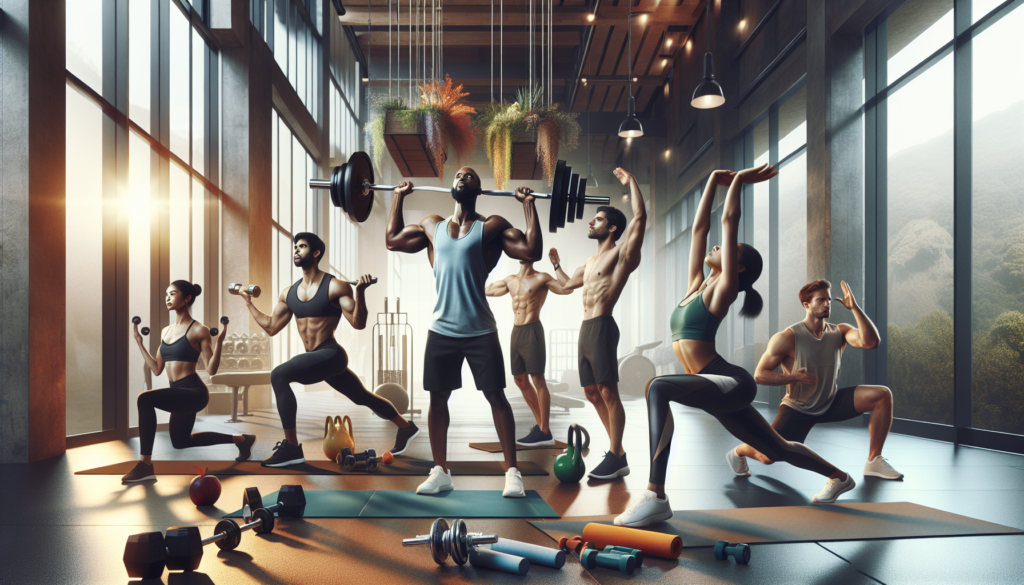Unlock Your Fitness Potential: 5 Exercise Routines to Transform Your Body Today

Unlock Your Fitness Potential: 5 Exercise Routines to Transform Your Body Today
What if I told you that by dedicating just 30 minutes a day to exercise, you could dramatically improve not only your physical health but also your mental clarity, creativity, and overall productivity? For entrepreneurs and content creators, whose success hinges on their energy and focus, the importance of fitness cannot be overstated. Transform your body and mind with these 5 effective exercise routines, designed to fit into even the busiest of schedules.
1. Importance of Fitness for Entrepreneurs and Content Creators
Fitness is not just about looking good; it’s about feeling good. For entrepreneurs and content creators, maintaining a high level of fitness can boost energy levels, mental clarity, and creativity. Regular exercise can also reduce stress and improve time management, allowing you to tackle your work responsibilities with more focus and efficiency.
2. Overview of the Article
In this article, we will dive into 5 transformative exercise routines that require minimal time and equipment. From circuit training to yoga, we will explore the benefits of each routine and provide sample workouts to get you started. Additionally, we will discuss how to create a sustainable fitness plan and answer some common questions to help you embark on your fitness journey.

5 Exercise Routines to Transform Your Body
2.1. Routine 1: Full-Body Circuit Training
Circuit training is a highly effective way to work multiple muscle groups in a short amount of time. It involves performing a series of exercises in a circuit, with minimal rest between exercises.
2.1.1. Benefits of Circuit Training
- Time-Efficient: You can complete a full-body workout in 20-30 minutes.
- Burns Fat: High-intensity circuits can help burn calories both during and after the workout.
- Improves Cardiovascular Health: Keeps your heart rate up throughout the session.
2.1.2. Sample Circuit Workout
Here’s a simple circuit to get you started:
- Push-Ups (30 seconds)
- Squats (30 seconds)
- Plank (30 seconds)
- Jumping Jacks (30 seconds)
- Mountain Climbers (30 seconds)
Perform each exercise for 30 seconds, rest for 30 seconds, and repeat the circuit 3-4 times.
2.2. Routine 2: High-Intensity Interval Training (HIIT)
HIIT is a method of training that involves alternating between periods of intense effort and recovery. This type of training can be extremely effective for improving cardiovascular fitness and burning fat.
2.2.1. Why HIIT is Effective
- Maximizes Calorie Burn: HIIT can burn more calories in a shorter time compared to steady-state cardio.
- Improves Aerobic and Anaerobic Fitness: It enhances both heart health and muscle strength.
- Boosts Metabolism: HIIT can increase your resting metabolic rate for hours after the workout.
2.2.2. Sample HIIT Workout
Try this HIIT routine:

- Sprinting (30 seconds)
- Walking (30 seconds)
- Burpees (30 seconds)
- Rest (30 seconds)
Repeat the above sequence 4-5 times.
2.3. Routine 3: Strength Training for Busy Schedules
Strength training is crucial for maintaining muscle mass and bone density. While many believe it requires hours in the gym, effective strength training can be done in short, focused sessions.
2.3.1. Importance of Strength Training
- Boosts Metabolism: Muscle tissue burns more calories at rest compared to fat.
- Improves Functional Strength: Helps with daily activities, from lifting boxes to carrying groceries.
- Enhances Mood: Strength training can reduce symptoms of anxiety and depression.
2.3.2. Sample Strength Workout
Here’s a straightforward strength workout:
- Dumbbell Squats (3 sets of 12-15 reps)
- Lunges (3 sets of 12-15 reps per leg)
- Push-Ups (3 sets of 10-12 reps)
- Dumbbell Rows (3 sets of 12-15 reps)
Rest for 30-60 seconds between sets.
2.4. Routine 4: Yoga for Flexibility and Mindfulness
Yoga is not just a physical practice; it is a way to enhance both flexibility and mindfulness. Incorporating yoga into your routine can help reduce stress, improve focus, and promote overall well-being.
2.4.1. Benefits of Yoga
- Increased Flexibility: Helps improve range of motion and reduces risk of injury.
- Stress Reduction: Promotes relaxation and mindfulness, helping to reduce anxiety and stress.
- Improved Balance: Enhances both physical and mental balance.
2.4.2. Sample Yoga Sequence
Here’s a simple 20-minute yoga sequence:
- Child’s Pose (1 minute)
- Cat-Cow Stretch (1 minute)
- Downward Dog (1 minute)
- Warrior I (1 minute per side)
- Tree Pose (1 minute per side)
- Savasana (5 minutes)
2.5. Routine 5: Cardio for Heart Health
Cardiovascular exercise is essential for maintaining a healthy heart and lungs. Regular cardio can improve endurance, reduce the risk of heart disease, and help with weight management.
2.5.1. Why Cardio Matters
- Heart Health: Reduces the risk of heart disease, the leading cause of death in the U.S.
- Weight Management: Cardiovascular activities help to burn calories, aiding in weight loss or maintenance.
- Mood Enhancement: Cardio releases endorphins, which can improve mood and reduce stress.
2.5.2. Sample Cardio Sessions
Try these cardio sessions to keep things fresh:
- Jogging for 20-30 minutes, 3-5 times a week
- Cycling for 30-45 minutes, 2-3 times a week
- Swimming for 20-30 minutes, 2 times a week
Creating a Sustainable Fitness Plan
3.1. Setting Realistic Goals
Setting achievable fitness goals is crucial for maintaining motivation. Start with small, realistic targets and gradually increase the intensity or duration of your workouts as you progress.
3.2. Incorporating Workouts into a Busy Schedule
To make fitness a priority, try to:
- Schedule Workouts: Treat your exercise time as you would any important meeting.
- Utilize Short Sessions: Even 10-15 minutes of exercise can make a significant difference.
- Be Flexible: If you miss a session, don’t stress; just pick it back up when you can.
3.3. Importance of Nutrition in Fitness
Nutrition plays a vital role in achieving and maintaining fitness goals. Focus on:
- Balanced Diet: Incorporate protein, carbohydrates, and fats in every meal.
- Hydration: Drink adequate water to keep your body functioning optimally.
- Post-Workout Nutrition: Refuel with a mix of protein and carbohydrates post-exercise.
FAQs
4.1. How often should I exercise?
- Aim for at least 150 minutes of moderate aerobic activity or 75 minutes of vigorous aerobic activity per week, along with strength training exercises 2-3 times a week.
4.2. What equipment do I need for these routines?
- For circuit training, HIIT, and strength training, consider a set of dumbbells, a resistance band, and a yoga mat. Cardio can be done without equipment or with minimal tools like a jump rope.
4.3. Can I do these workouts at home?
- Absolutely! Most of these routines can be completed at home with minimal or no equipment.
4.4. What should I eat before and after a workout?
- Before a workout, opt for a light snack with carbohydrates and protein (e.g., a banana and a hard-boiled egg). Post-workout, refuel with a balanced meal that includes protein and complex carbohydrates.
4.5. How do I track my progress?
- Use a fitness tracker, a simple notebook, or smartphone apps to log your workouts, weight, and measurements. Tracking your progress can help keep you motivated and accountable.
Conclusion
Unlocking your fitness potential is not just about following a routine;


